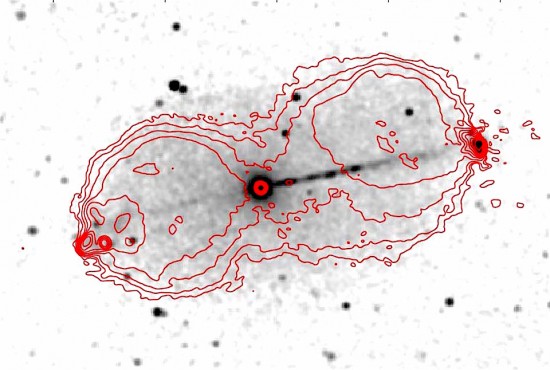
X-ray jets from the galaxy Pictoris A. Red contours show the radio emission. NASA/Chandra, Hardcastle et al.
Sep 8, 2016
X-rays in space.
A recent press release from the Chandra X-ray Observatory reports that “strong winds” are racing outward from the core of Pictoris A, a galaxy said to be 500 million light-years away in the constellation Pictor. A supermassive black hole (SMBH) is the culprit, according to astronomers. Hot gas around its event horizon is accelerated until gravity can no longer hold it in place. The gas is said to be heated by the SMBH until it is hot enough to emit X-rays, whereupon it is ejected along a tangential trajectory.
To say that gas can be heated until it gives off X-rays and “blows like a wind” betrays a serious lack of understanding, or a careless presentation of observations. No gas can remain intact at such temperatures because electrons will be stripped from the nuclei, causing it to change state into a plasma.
X-rays in space, no matter the source, are not created in gravity fields regardless of how strong they are theorized to be. Charged particles (plasma) accelerated by electric currents spiral in the resulting magnetic fields and shine in all high energy frequencies.
As previously written, in a galactic circuit, electric power flows inward along the spiral arms where it is concentrated and stored in the central plasmoid, or galactic bulge. When it reaches a certain current density it discharges, usually out of the galaxy’s spin axis as an energetic jet of plasma. Laboratory experiments have replicated the phenomenon with a plasma focus device.
Electromagnetic forces confine those jets into thin filaments that remain coherent for thousands of light-years. Chandra’s observations of Pictoris A indicate that material from the galactic core reaches more than one million light-years from its source, but that estimate could be off by a significant factor. Jets usually end in double layer lobes that extend for many times the size of the galaxy and radiate copiously in radio frequencies. The diffuse currents then flow toward the galaxy’s equatorial plane and spiral back into its nucleus.
Hannes Alfvén identified the “exploding double layer” as a new class of celestial object. It is double layers in space plasmas that form most of the unusual structures seen by telescopes. Galactic jets, toroids, and glowing clouds are all examples of electricity flowing through dusty plasma confined within Birkeland currents that stretch across the light years.
Stephen Smith












